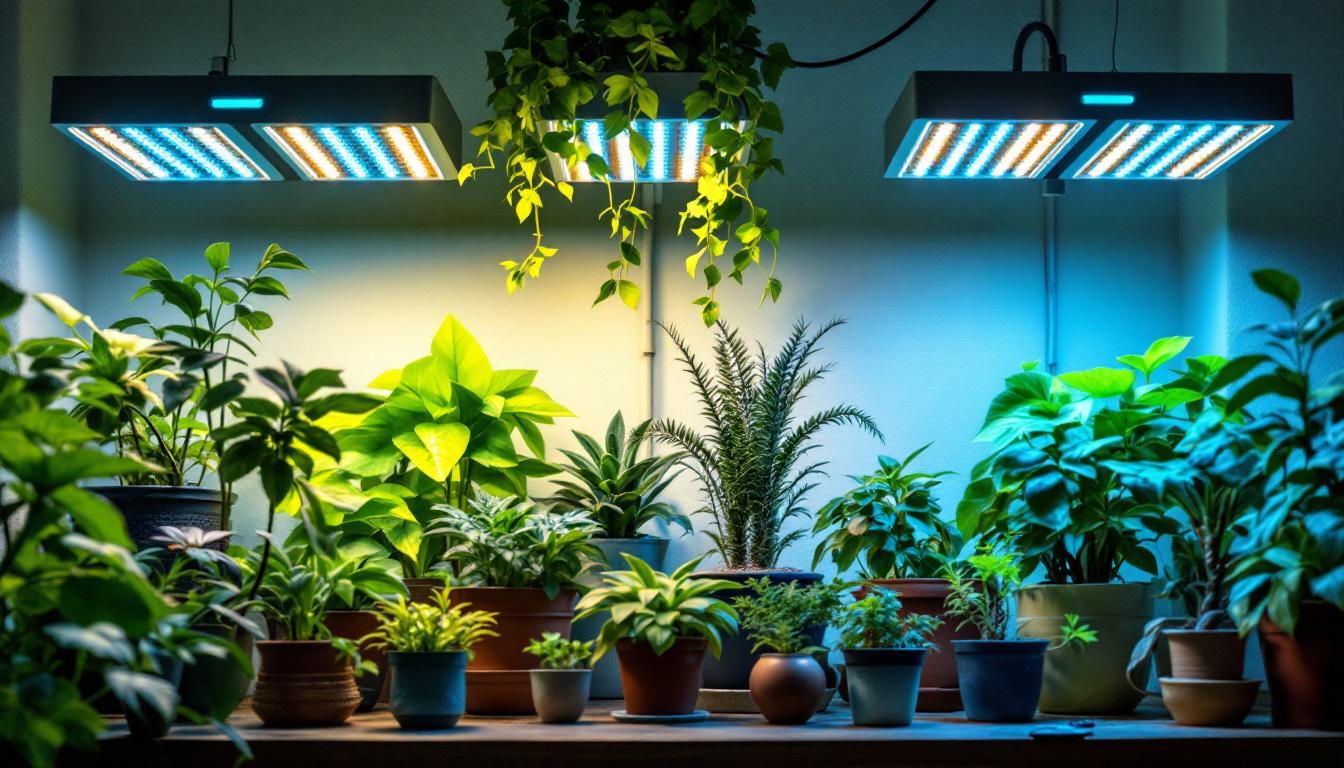
Lamps designed specifically for growing plants have become an essential tool for lighting contractors involved in horticulture and indoor gardening projects. These specialized lamps not only provide the necessary illumination for photosynthesis but also enhance plant growth and health. Understanding the different types of grow lamps, their applications, and how to effectively integrate them into lighting projects is crucial for achieving successful outcomes.
Grow lamps are artificial light sources that emit wavelengths suitable for plant growth. They are designed to mimic the natural sunlight that plants require for photosynthesis, which is vital for their development. The spectrum of light emitted by these lamps can be tailored to meet the specific needs of various plants, making them versatile for a range of gardening applications.
There are several types of grow lamps available, each with unique characteristics suited for different growing conditions. The most common types include fluorescent, LED, high-intensity discharge (HID), and incandescent lamps. Understanding the differences between these types is essential for selecting the right lamp for a specific project.
Fluorescent lamps are popular for their energy efficiency and low heat output, making them ideal for small indoor gardens. They are available in various sizes and can provide a balanced spectrum for seedling growth. On the other hand, LED grow lights have gained popularity due to their longevity and ability to emit specific wavelengths of light, which can be adjusted based on the growth stage of the plants.
The primary benefit of using grow lamps is the ability to control the light environment for plants. This control allows for year-round gardening, regardless of external weather conditions. Grow lamps can also be tailored to provide the optimal light spectrum for different plant species, promoting healthier growth and increased yields.
Additionally, grow lamps can help extend the growing season for outdoor plants by providing supplemental light during shorter days. This is particularly beneficial for crops that require longer daylight hours to thrive. By utilizing grow lamps, lighting contractors can offer clients enhanced growing solutions that maximize productivity.
Selecting the appropriate grow lamp involves considering several factors, including the type of plants being grown, the size of the growing area, and the specific growth stage of the plants. Each lamp type has its own advantages and drawbacks, making it essential to assess the project requirements carefully.
Different plants have varying light requirements, and understanding these needs is crucial when choosing a grow lamp. For instance, blue light is essential for vegetative growth, while red light is more beneficial during the flowering stage. Some grow lamps provide a full spectrum, which can support plants throughout their entire growth cycle.
For lighting contractors, being knowledgeable about the specific light spectrum required for different plants can enhance their ability to recommend the best solutions to clients. This expertise not only builds trust but also contributes to the overall success of the gardening projects.
Energy efficiency is a significant consideration when selecting grow lamps. LED lights, for example, consume less electricity and have a longer lifespan compared to traditional incandescent or HID lamps. Although the initial investment in LED technology may be higher, the long-term savings on energy bills and replacement costs can be substantial.
Lighting contractors should also consider the total cost of ownership, which includes installation, maintenance, and operational costs. Providing clients with a comprehensive understanding of these factors can help them make informed decisions that align with their budget and sustainability goals.
Proper installation and setup of grow lamps are critical for ensuring optimal performance. Factors such as lamp placement, height, and spacing can significantly impact the effectiveness of the lighting system. Lighting contractors must be well-versed in these technical aspects to deliver successful projects.
The placement of grow lamps should be strategically planned to ensure even light distribution across the growing area. Lamps should be positioned at an appropriate height to avoid burning plants while still providing adequate light intensity. As plants grow, height adjustments may be necessary to maintain the right distance between the lamp and the foliage.
Lighting contractors should also consider the growth habits of the plants being cultivated. For instance, taller plants may require higher lamp placements, while shorter plants can benefit from closer proximity to the light source. This adaptability is essential for maximizing plant growth and health.
Incorporating reflectors into the lighting setup can enhance light distribution and efficiency. Reflectors help direct light towards the plants, reducing waste and ensuring that every plant receives adequate illumination. This is particularly important in larger growing areas where shadows can form and hinder growth.
Lighting contractors can recommend various reflector options based on the type of grow lamp used and the specific needs of the project. By optimizing light distribution, contractors can significantly improve the effectiveness of the lighting system.
Regular maintenance of grow lamps is essential for ensuring their longevity and performance. Over time, dust and debris can accumulate on the lamp surfaces, reducing light output and efficiency. Lighting contractors should educate clients on proper maintenance practices to keep their grow lamps functioning optimally.
Cleaning grow lamps should be a routine part of the maintenance process. A simple dusting or wiping down of the lamp surfaces can significantly improve light output. It is advisable to use non-abrasive cleaning materials to avoid damaging the lamp components.
In addition to cleaning, contractors should also recommend regular inspections of the electrical components and wiring. Ensuring that all connections are secure and free from corrosion can prevent potential electrical issues and enhance safety.
Knowing when to replace grow lamps is crucial for maintaining optimal plant growth. Most lamps have a specific lifespan, after which their light output diminishes significantly. Lighting contractors should monitor the performance of the lamps and advise clients on when replacements are necessary.
Moreover, advancements in lighting technology, such as the development of more energy-efficient LEDs, provide opportunities for upgrades. Contractors can inform clients about the benefits of upgrading their existing systems to improve energy efficiency and plant health.
Examining successful case studies can provide valuable insights into the effective use of grow lamps in various projects. These examples can serve as inspiration for lighting contractors looking to enhance their offerings and demonstrate the potential benefits of specialized lighting solutions.
One notable example of successful grow lamp application is in indoor hydroponic systems. These systems rely heavily on artificial lighting to create optimal growing conditions for plants. By using a combination of LED and fluorescent grow lamps, contractors have been able to create highly efficient systems that yield impressive results.
In these projects, careful attention was paid to the light spectrum, ensuring that plants received the right wavelengths for each growth stage. This resulted in faster growth rates and higher-quality produce, showcasing the effectiveness of well-planned lighting solutions.
Another successful application of grow lamps can be seen in commercial greenhouses. These facilities often face challenges related to inconsistent natural light due to seasonal changes. By integrating high-intensity discharge lamps with automated control systems, contractors have been able to maintain consistent light levels, regardless of external conditions.
This approach has not only improved crop yields but also allowed for year-round production, significantly increasing profitability for greenhouse operators. The success of these projects highlights the importance of tailored lighting solutions in commercial horticulture.
The field of grow lighting is continuously evolving, with new technologies and trends emerging regularly. Staying informed about these developments is essential for lighting contractors looking to remain competitive and offer the best solutions to their clients.
One of the most exciting trends in grow lighting is the rise of smart lighting solutions. These systems utilize sensors and automation to optimize light levels based on real-time environmental conditions. By integrating smart technology, contractors can provide clients with more efficient and adaptable lighting systems that respond to the needs of the plants.
Smart lighting solutions not only enhance plant growth but also improve energy efficiency, making them a win-win for both growers and the environment. As this technology continues to advance, lighting contractors will need to familiarize themselves with these innovations to offer cutting-edge solutions.
Another significant trend is the increasing emphasis on sustainability in horticulture. Grow lamps that are energy-efficient and made from eco-friendly materials are becoming more popular. Lighting contractors should consider incorporating sustainable practices into their projects, such as using recyclable components and promoting energy-efficient technologies.
By aligning with sustainability goals, contractors can appeal to environmentally conscious clients and contribute to a more sustainable future in horticulture. This commitment to eco-friendly practices can also enhance a contractor’s reputation and attract new business opportunities.
In conclusion, grow lamps are an indispensable tool for lighting contractors involved in horticulture and indoor gardening projects. By understanding the various types of grow lamps, their benefits, and how to effectively implement them, contractors can significantly enhance the success of their lighting projects. With the ongoing advancements in technology and a growing emphasis on sustainability, the future of grow lighting holds exciting possibilities for contractors and their clients alike.
Investing in knowledge and expertise in grow lighting not only benefits individual projects but also positions lighting contractors as leaders in the industry. As the demand for specialized lighting solutions continues to rise, those who adapt and innovate will thrive in this dynamic field.
Ready to elevate your horticulture and indoor gardening projects with the best grow lamps on the market? Look no further than LumenWholesale, where we provide lighting contractors with superior, spec-grade lighting products at unbeatable wholesale prices. Say goodbye to local distributor markups and hello to our extensive selection that meets the highest industry standards. With LumenWholesale, you can count on reliable, high-performance lighting that brings your projects to life. Plus, enjoy the convenience of bulk buying with free shipping, ensuring you get premium lighting at the best value — without hidden fees. Don’t compromise on quality or affordability. Explore our collection now and discover the perfect blend of quality, affordability, and convenience at LumenWholesale.

Explore the often-overlooked aspects of lighting design that even seasoned contractors miss.

Discover essential tips and common pitfalls to avoid when installing dust to dawn lights in this comprehensive guide for lighting contractors.

Discover expert insights on selecting and installing outside door lamps with ease.

Discover the advantages and drawbacks of high bay LED light fixtures for lighting contractors.